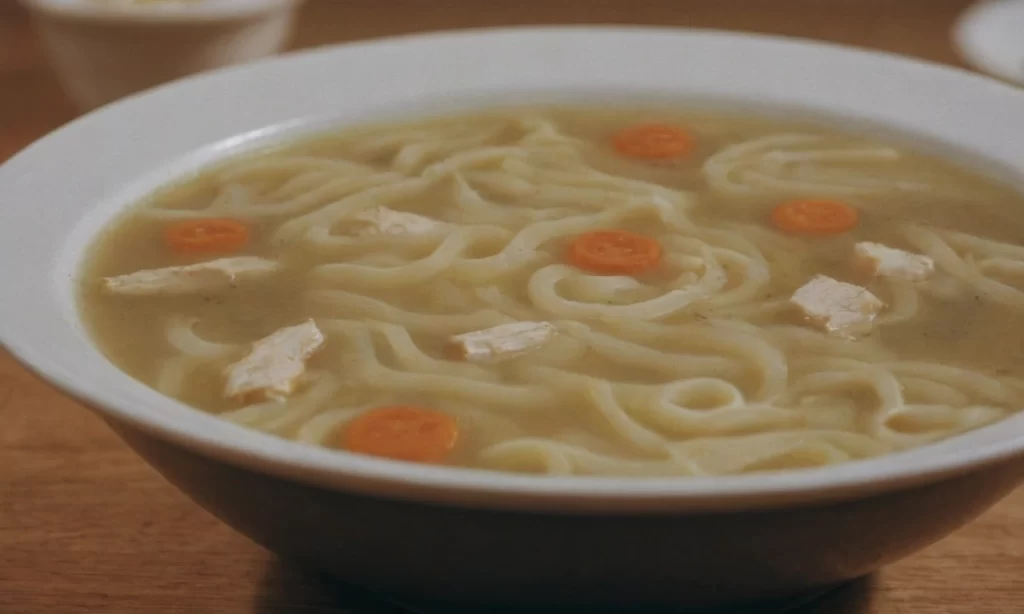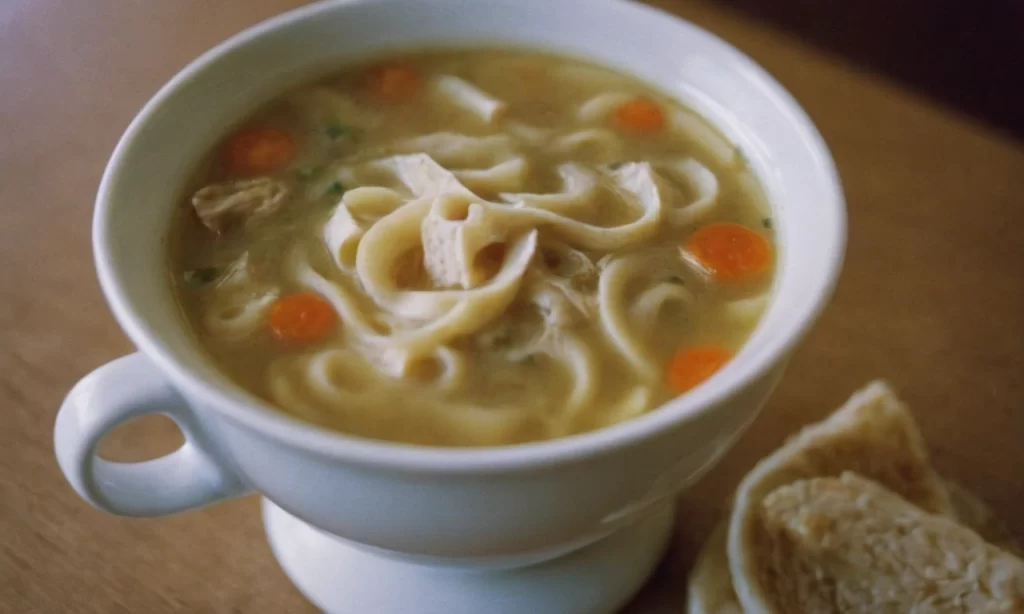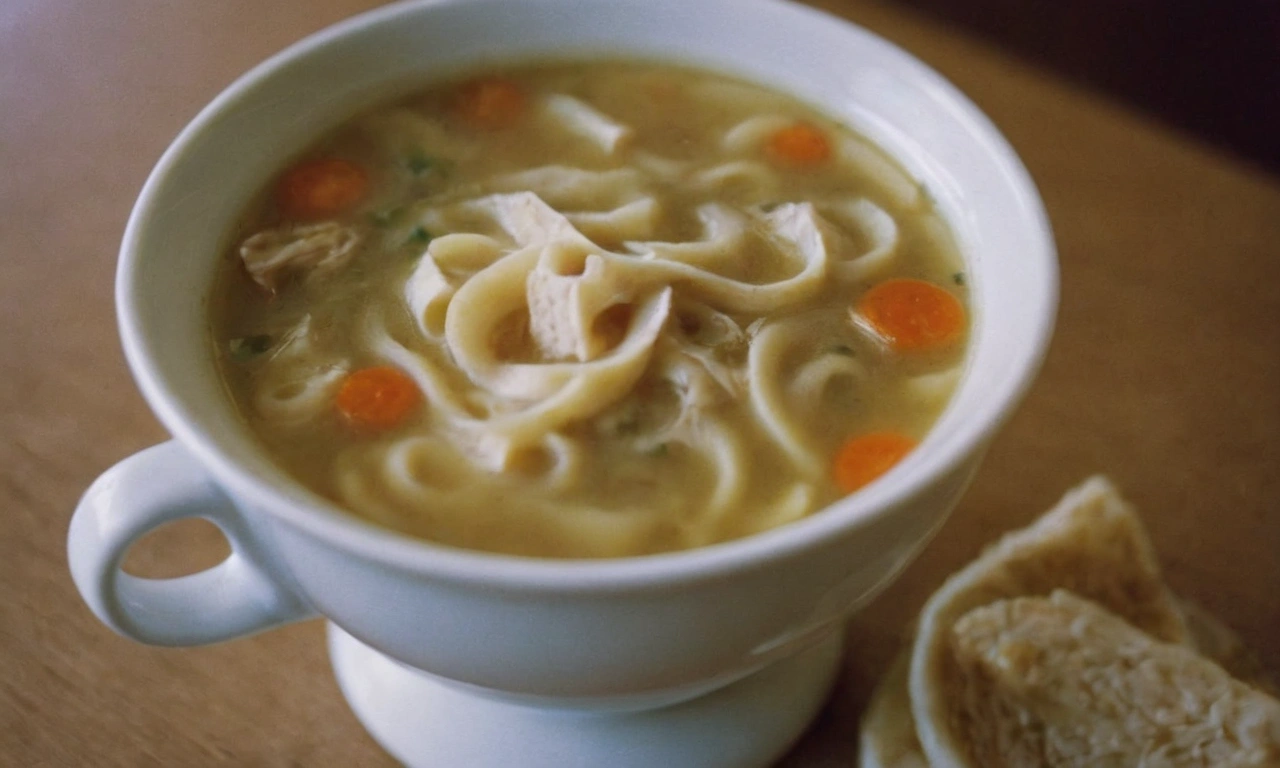In the comforting world of homemade dishes, chicken noodle soup stands out as a beacon of warmth and nourishment. It’s a classic remedy for cold days and gloomy moods, carrying the essence of home in every spoonful. But what happens when you’ve made a cauldron full of this comforting elixir and can’t possibly finish it before it spoils? The question arises: “Can you freeze chicken noodle soup?” This article dives deep into the freezing realm, uncovering the secrets to preserving your soup without compromising its soul-soothing flavors and textures. Join us as we navigate through the dos and don’ts, ensuring your soup remains a ready-to-reheat treasure for those days when cooking is off the table.
Introduction to Freezing Chicken Noodle Soup

The Importance of Preserving Chicken Noodle Soup
Ever found yourself stirring a pot of chicken noodle soup, pondering over the age-old question: “Can you freeze chicken noodle soup?” Well, you’re not alone. This culinary conundrum has puzzled many, as the thought of wasting such a delightful concoction is downright distressing. Fear not, for freezing is a splendid way to extend the life of your soup, ensuring that none of that homemade goodness goes to waste.
Freezing chicken noodle soup is more than just about saving leftovers; it’s about preserving a feeling, a memory, a taste of home that can be revisited with each reheated bowl. Imagine the relief and joy of finding a batch of your beloved soup in the freezer after a long, tiring day. It’s like a hug from the past, ready to comfort you in the present.
However, the journey from pot to freezer isn’t as straightforward as one might think. The process involves careful preparation and an understanding of how ingredients react in the frosty confines of your freezer. But fret not, for we’re here to guide you through every step, ensuring that your soup freezes beautifully and reheats to perfection, bringing back that homemade deliciousness without a hint of compromise.
In the following sections, we’ll unravel the mysteries of freezing chicken noodle soup, from selecting the right ingredients to the thawing and reheating process. So, roll up your sleeves and get ready to transform your soup into a freeze-friendly feast.
Stay tuned as we delve into the nitty-gritty of preparing your chicken noodle soup for its chilly hibernation. You’ll discover that with a pinch of knowledge and a dash of care, freezing this comfort food classic is a breeze, ensuring that its heartwarming embrace is but a thaw away.
Learn the best techniques for long-lasting, delicious soup.
The Basics of Freezing Soup
Can You Freeze Chicken Noodle Soup?
The short answer is a resounding “Yes!” But, and it’s a considerable ‘but’, not all soups are created equal when it comes to freezing. Chicken noodle soup, with its delicate balance of broth, vegetables, and pasta, requires a bit more finesse to freeze well. The key lies in understanding the freezing process and how it affects each component of your soup.
Freezing is like a pause button for food, slowing down spoilage by turning water into ice and halting the growth of most bacteria. However, this process can also alter textures, especially in foods with high water content, like our beloved soup. The trick is to freeze your soup in a way that minimizes these changes, ensuring that your reheated soup is as close to the original as possible.
Benefits of Freezing Chicken Noodle Soup
Why go through the trouble, you might ask? Well, freezing chicken noodle soup isn’t just about convenience; it’s a smart move for several reasons:
- Waste Not, Want Not: In a world where food waste is a growing concern, freezing your leftover soup is a small step towards more sustainable eating habits. It’s a win-win, really. You reduce waste and ensure that a comforting meal is always within reach.
- Ready in a Pinch: Life can be unpredictable, and on days when time or energy is in short supply, having a meal as comforting and nutritious as chicken noodle soup ready to go is a true blessing.
- Nutritional Preservation: Freezing locks in the vitamins and minerals present in your soup, ensuring that you don’t lose out on the good stuff even after weeks in the cold.
In the next sections, we’ll dive deeper into the art of preparing and freezing your chicken noodle soup, ensuring that every bowl you reheat in the future is as comforting and delightful as it was when first made. From choosing the right ingredients to the final freeze, we’ve got you covered, ensuring your soup remains a beacon of comfort, no matter when you choose to enjoy it.
Preparing Soup for Freezing
Selecting Ingredients for Freezable Chicken Noodle Soup
When it comes to freezing chicken noodle soup, not all ingredients are created equal. The secret to a successfully frozen soup lies in the initial selection of ingredients. Fresh, high-quality components are your best bet for a soup that freezes and reheats well. But, the real game-changer? The pasta. Opting for sturdy pasta like whole wheat or egg noodles can make all the difference. These types are more forgiving in the freeze-thaw-reheat cycle, helping your soup maintain its beloved texture.
Cooking your noodles to al dente perfection is crucial. You’re aiming for noodles that are firm to the bite, as they’ll continue to soften slightly during the reheating process. This little trick keeps the noodles from turning into mush and ensures that your soup retains that delightful homemade feel.
Cooking Techniques for Freezable Soup
Now, let’s talk about the cook. The way you prepare your chicken noodle soup before it hits the freezer can significantly impact its post-thaw quality. Here’s a hot tip: slightly undercook your vegetables. Just like the pasta, they’ll continue cooking upon reheating, ensuring they don’t turn into a soggy disappointment.
Another pro move is to consider separating the noodles from the broth when freezing. This might seem like a bit of a hassle, but it’s a fantastic way to maintain the ideal texture of both components. You can freeze the broth with the chicken and vegetables, and the noodles separately, combining them only when you’re ready to reheat.
By paying attention to these details during the preparation phase, you’re setting your chicken noodle soup up for freezing success. These steps help preserve the soup’s texture, flavor, and overall quality, ensuring that every reheated bowl is a warm embrace from your kitchen.
Up next, we’ll explore the best practices for packaging and freezing your soup, sealing in that homemade goodness for future enjoyment. Stay tuned, as we continue to unlock the secrets to freezing chicken noodle soup with finesse.
Preparing Soup for Freezing
Selecting Ingredients for Freezable Chicken Noodle Soup
The journey to a successfully frozen chicken noodle soup begins at the very start: selecting the right ingredients. The choice of components plays a pivotal role in how well your soup withstands the freezing and reheating process.
- Vegetables: Opt for hearty vegetables that freeze well, like carrots, celery, and peas. These tend to retain their texture and flavor even after freezing and reheating.
- Chicken: Choose quality chicken parts for a rich and flavorful broth. Remember, the better the quality, the more delicious your soup will be, both fresh and reheated.
- Noodles: This is crucial. For freezing, go for durable pasta like whole wheat or egg noodles, and cook them al dente. Al dente pasta, slightly firm to the bite, is less likely to turn mushy when reheated.
The golden rule here is freshness. Fresh, high-quality ingredients not only elevate the taste of your soup but also ensure that it freezes and reheats beautifully, maintaining the integrity of its flavors and textures.
Cooking Techniques for Freezable Soup
Once you’ve got your ingredients sorted, the next step is cooking your chicken noodle soup in a way that makes it freezer-friendly.
- Noodle Nuances: Cook your noodles just until they’re al dente. They’ll continue cooking slightly when you reheat the soup, so starting with slightly firmer noodles prevents them from turning to mush later on.
- Broth Basics: A rich, well-seasoned broth is the foundation of any good soup. However, be mindful of seasoning levels, especially with salt. Freezing can sometimes concentrate flavors, so it’s better to err on the side of caution and adjust seasoning after reheating if necessary.
By focusing on the quality of ingredients and adjusting your cooking techniques with freezing in mind, you’re setting your chicken noodle soup up for success. This way, when you’re ready to defrost and dive in, each bowl will be as nourishing and comforting as if it were made fresh that day. Stay tuned as we move on to the crucial steps of packaging and freezing your soup, ensuring its flavors are perfectly preserved for future enjoyment.
Packaging and Freezing
Proper Packaging Techniques for Freezing
Now that your chicken noodle soup is cooked to perfection with freeze-friendly ingredients and techniques, it’s time to focus on the next critical step: packaging. Proper packaging is essential to protect your soup from freezer burn and maintain its quality over time.
- Airtight Containers: Choose containers that seal tightly to keep air out, as exposure to air can lead to freezer burn, which affects the taste and texture of your soup. For more insights on avoiding freezer burn and choosing the right portion sizes, Taste of Home offers an excellent article on Freezing Soup effectively.
- Freezer Bags: If space is an issue, heavy-duty freezer bags are a great alternative. They can be laid flat to save space and easily stacked. Just make sure to squeeze out as much air as possible before sealing.
Labeling is also a key part of the packaging process. Clearly mark each container or bag with the contents and the date it was frozen. This practice helps you keep track of how long your soup has been in the freezer, ensuring you use it while it’s still at its best.
Step-by-Step Guide to Freezing Chicken Noodle Soup
Freezing chicken noodle soup is not just about tossing it into the freezer. Follow these steps to ensure your soup freezes well and retains its delicious flavor:
- Cool Your Soup: Allow the soup to cool to room temperature before freezing. This prevents the formation of ice crystals, which can affect the soup’s texture.
- Portion It Out: Divide the soup into portions. This way, you can thaw exactly what you need, reducing waste and ensuring freshness.
- Leave Some Space: When filling containers or bags, leave some room at the top. Liquids expand when frozen, and this extra space prevents containers from cracking or bags from bursting.
- Freeze Flat: If using freezer bags, lay them flat in the freezer until solid. This makes them easier to stack and saves space.
- Store Wisely: Place your soup in the coldest part of the freezer to ensure it freezes quickly and evenly.
Next, we’ll explore the best practices for thawing and reheating your frozen soup, ensuring it returns to its original, comforting state with every reheated bowl.
Thawing and Reheating

Thawing is just as important as freezing when it comes to preserving the taste and texture of your chicken noodle soup. There are a couple of safe and effective methods to bring your soup back to a liquid state, ready for reheating.
- Fridge Thawing: The most reliable method is to transfer the frozen soup to your refrigerator and let it thaw slowly, usually overnight. This gradual process helps maintain the integrity of the ingredients.
- Microwave Thawing: If you’re in a bit of a rush, you can use your microwave to thaw the soup. Just be sure to use the defrost setting and stir occasionally for even thawing. Remember, once thawed, it should be reheated and consumed promptly.
Whichever method you choose, make sure to plan ahead to give your soup enough time to thaw properly, ensuring the best possible outcome when it comes time to reheat.
Best Practices for Reheating
Reheating your chicken noodle soup properly is crucial to enjoying it at its best. Here’s how to ensure your reheated soup is just as comforting and delicious as when it was first made:
- Stovetop Reheating: Gently reheat the soup in a pot on the stove over low to medium heat, stirring occasionally. This method allows for even heating and lets you easily monitor the soup’s temperature.
- Microwave Reheating: If you prefer using a microwave, transfer the soup to a microwave-safe bowl, cover it, and reheat in short intervals, stirring in between to ensure even heating.
During reheating, avoid bringing the soup to a boil, as this can make the noodles mushy and overcook the vegetables. Instead, aim for a gentle simmer just until the soup is heated through. Always check the temperature before serving; your soup should reach 165°F (74°C) to ensure it’s safe to eat.
Following these thawing and reheating guidelines will help maintain the delightful taste and comforting warmth of your chicken noodle soup, making it a reliable source of comfort on any given day. Stay tuned for our final thoughts and tips on enjoying your perfectly preserved chicken noodle soup, ensuring that this classic comfort food is ready to soothe and satisfy whenever the craving strikes.
FAQs
When it comes to freezing chicken noodle soup, a handful of questions frequently pop up.
- How long does chicken noodle soup last in the freezer? Chicken noodle soup can maintain its best quality in the freezer for about 2 to 3 months. While it remains safe to eat beyond this time, you might start noticing a gradual decline in flavor and texture.
- Can you freeze chicken noodle soup in mason jars? Yes, but with caution. Use only wide-mouth mason jars and leave ample space at the top for expansion. Ensure the soup is completely cooled before freezing to prevent the jars from cracking.
- Does freeze-drying chicken noodle soup affect its taste? Freeze-drying chicken noodle soup can preserve its flavor and nutritional value effectively. However, the texture, especially of the noodles, may change slightly upon rehydration. It’s a trade-off between convenience and a slight alteration in texture.
Addressing these FAQs can help alleviate concerns and clarify common misconceptions about freezing chicken noodle soup. With this knowledge, you can embrace freezing as a convenient and effective method to extend the life of your soup without sacrificing its comforting essence.
In our next section, we’ll wrap up with a conclusion that encapsulates the joy and convenience of having a batch of chicken noodle soup ready in your freezer, ensuring a wholesome and heartwarming meal is just a thaw and reheat away.
Conclusion
Freezing chicken noodle soup allows you to capture and preserve the essence of home-cooked warmth and nutrition, making it an invaluable trick for any home cook’s repertoire.
Remember, the key to a successfully frozen chicken noodle soup lies in the quality of ingredients, the preparation method, and the freezing technique. By following the steps outlined in this guide, from selecting robust ingredients to proper cooling and storage, you ensure that each bowl reheated from the freezer brings back the comforting and nourishing embrace of a freshly made soup.
For those eager to dive deeper into the world of chicken noodle soup, exploring various recipes can provide a broader canvas to apply these freezing principles. Whether it’s the traditional flavors of Grandma’s Chicken Noodle Soup or the rich and fulfilling experience offered by the Ultra Satisfying Chicken Noodle Soup, there’s a whole world of chicken noodle soup waiting to be savored, frozen, and savored again.
In the end, the ability to freeze chicken noodle soup effectively means that the comfort, taste, and nutritional benefits of this beloved dish are never more than a thaw away. So, the next time you find yourself with a potful of soup and a heart full of warmth, remember that freezing is not just about preservation—it’s about ensuring that comfort food is always within reach, ready to soothe, nourish, and delight at a moment’s notice.

